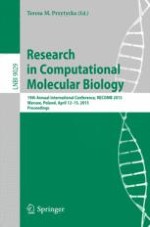2015 | OriginalPaper | Buchkapitel
Deep Feature Selection: Theory and Application to Identify Enhancers and Promoters
verfasst von : Yifeng Li, Chih-Yu Chen, Wyeth W. Wasserman
Erschienen in: Research in Computational Molecular Biology
Aktivieren Sie unsere intelligente Suche, um passende Fachinhalte oder Patente zu finden.
Wählen Sie Textabschnitte aus um mit Künstlicher Intelligenz passenden Patente zu finden. powered by
Markieren Sie Textabschnitte, um KI-gestützt weitere passende Inhalte zu finden. powered by
Sparse linear models approximate target variable(s) by a sparse linear combination of input variables. The sparseness is realized through a regularization term. Since they are simple, fast, and able to select features, they are widely used in classification and regression. Essentially linear models are shallow feed-forward neural networks which have three limitations: (1) incompatibility to model non-linearity of features, (2) inability to learn high-level features, and (3) unnatural extensions to select features in multi-class case. Deep neural networks are models structured by multiple hidden layers with non-linear activation functions. Compared with linear models, they have two distinctive strengths: the capability to (1) model complex systems with non-linear structures, (2) learn high-level representation of features. Deep learning has been applied in many large and complex systems where deep models significantly outperform shallow ones. However, feature selection at the input level, which is very helpful to understand the nature of a complex system, is still not well-studied. In genome research, the
cis
-regulatory elements in non-coding DNA sequences play a key role in the expression of genes. Since the activity of regulatory elements involves highly interactive factors, a deep tool is strongly needed to discover informative features. In order to address the above limitations of shallow and deep models for selecting features of a complex system, we propose a deep feature selection model that (1) takes advantages of deep structures to model non-linearity and (2) conveniently selects a subset of features right at the input level for multi-class data. We applied this model to the identification of active enhancers and promoters by integrating multiple sources of genomic information. Results show that our model outperforms elastic net in terms of size of discriminative feature subset and classification accuracy.
